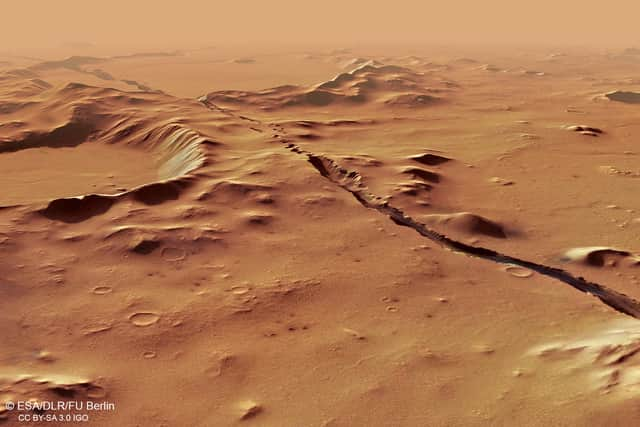‘Alien bugs’ could be living deep underground on Mars, according to new research
This article contains affiliate links. We may earn a small commission on items purchased through this article, but that does not affect our editorial judgement.
and live on Freeview channel 276
Alien bugs could be living deep underground on Mars, according to new research. The Red Planet is volcanically active, suggesting the right ingredients for present-day microbial life.
A giant column of hot rock which is 2,500 miles wide lies below the northern plains of the planet, say scientists, likened to hot blobs of wax rising in lava lamps. These blobs generate methane and hydrogen, which can be used by bacteria for energy.
Advertisement
Hide AdAdvertisement
Hide AdThe phenomenon has already been identified on Earth - and may be happening on Mars. The discovery has implications for life on the planet and NASA rover Perseverance is currently drilling for evidence.
The studied region experienced mysterious floods of liquid water in its recent geologic past and it is believed heat from the plume melted surface ice, driving chemical reactions that could sustain life. Co-author Professor Jeff Andrews-Hanna said: "Microbes on Earth flourish in environments like this. That could be true on Mars, as well."
A research team from Arizona University combined orbital observations and geophysical computer models, showing the plume is rising from deep inside, pushing up a plain called Elysium Planitia. Its epicentre was traced to an 800 mile stretch of fissures named Cerberus Fossae, south east of the Elysium Mons volcanic complex.
This region harbours molten lava and most martian quakes emanate from it. On Earth shifting tectonic plates reshuffle the planet’s surface and make for a dynamic interior - the island chain of Hawaii formed as the Pacific plate slowly drifted over a plume.
Advertisement
Hide AdAdvertisement
Hide AdMars was thought to be “dead” as not much has happened on the planet in the past three billion years. The study adds to growing evidence it’s very much alive with quakes and volcanic eruptions.
Professor Andrews-Hanna said: "We have strong evidence for mantle plumes being active on Earth and Venus. But this isn’t expected on a small and supposedly cold world like Mars. Mars was most active 3 to 4 billion years ago and the prevailing view is the planet is essentially dead today."


But volcanism is shaping the surface even now, perhaps providing favourable conditions for microbial life. Dr Broquet said: "A tremendous amount of volcanic activity early in the planet’s history built the tallest volcanoes in the solar system and blanketed most of the northern hemisphere in volcanic deposits.
“What little activity has occurred in recent history is typically attributed to passive processes on a cooling planet."
Advertisement
Hide AdAdvertisement
Hide AdElysium Planitia is close to the equator. Unlike other volcanic regions on Mars, which haven’t seen major activity for billions of years, it experienced large eruptions over the past 200 million years.
Prof Andrews-Hanna added: "Previous work by our group found evidence in Elysium Planitia for the youngest volcanic eruption known on Mars. It created a small explosion of volcanic ash around 53,000 years ago - which in geologic time is essentially yesterday."
On Earth, volcanism and earthquakes are linked with mantle plumes or plate tectonics - the global cycle of drifting continents. Dr Broquet said: "We know Mars does not have plate tectonics so we investigated whether the activity we see in the Cerberus Fossae region could be the result of a mantle plume.


"In terms of what you expect to see with an active mantle plume, Elysium Planitia is checking all the right boxes.This mantle plume has affected an area of Mars roughly equivalent to that of the continental United States.
Advertisement
Hide AdAdvertisement
Hide Ad"Future studies will have to find a way to account for a very large mantle plume that wasn’t expected to be there." The study has implications for interpreting seismic data recorded by the InSight Lander which touched down four years ago.
Dr Broquet said: "We used to think InSight landed in one of the most geologically boring regions on Mars - a nice flat surface that should be roughly representative of the planet’s lowlands. Instead, our study demonstrates InSight landed right on top of an active plume head.
"Having an active mantle plume on Mars today is a paradigm shift for our understanding of the planet’s geologic evolution - similar to when analyses of seismic measurements recorded during the Apollo era demonstrated the moon’s core to be molten."
The discovery reported in Nature Astronomy goes beyond explaining the enigmatic seismic activity. Prof Andrews-Hanna said: "Knowing there’s an active giant mantle plume underneath the Martian surface raises important questions regarding how the planet has evolved over time. We’re convinced that the future has more surprises in store."
Comment Guidelines
National World encourages reader discussion on our stories. User feedback, insights and back-and-forth exchanges add a rich layer of context to reporting. Please review our Community Guidelines before commenting.
